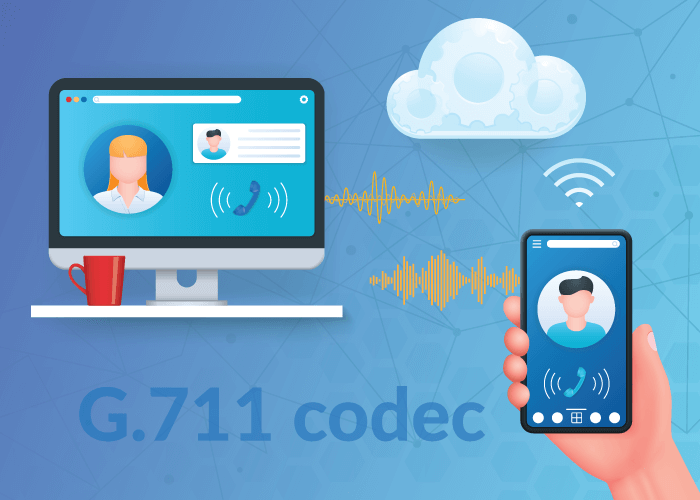When setting up a new VoIP phone system, you must equip the right voice codec to ensure reliable and clear call quality. The type of codec you need depends on your provider and phone system.
In this article, we’ll go over the G.711 codec and why it is the preferred codec for VoIP calling.
VoIP Codecs and Why They are Important
VoIP codecs are designed to convert analog voice signals to digital packets (compression) and then reassembled back into audio (decompression) when they arrive at their destination.
In doing so, they establish and maintain VoIP call quality and determine bandwidth use for incoming and outgoing calls. So, to ensure your teams can communicate effectively through your VoIP phone system, you will need to use the right codec — one supported by your provider.
You can adjust these voice codecs depending on what you need, such as better quality, evenly distributed bandwidth, etc.
What is G.711?
This codec uses packet loss concealment (PLC) to minimize the effect and impact of packets dropped during transmission. It was established in 1972 as the default pulse code modulation or PCM standard for IP PBX and PSTN networks.
There are two main algorithms for the G.711: The μ-law codec used in North America and Japan and the A-law codec used in the rest of the world. Additionally, G.711 μ-law offers more resolution to higher range signals. And the G.711 A-law offers more quantization at lower signal levels.
Why Choose the G.711 Codec for VoIP?
While there are a few different codecs for VoIP, the G.711 is the most preferred and most commonly offered by VoIP providers. And there’s a good reason for that. Here are a few reasons why the G.711 is one of the best codecs for VoIP calling:
- Two variants for worldwide usage (μ-law and A-law)
- High MOS call quality score of 4.2
- Uncompressed high-quality voice
- High bandwidth requirement
- Focus on precise speech transmission
- Good for LAN and VoIP to PSTN setups
- Most reliable call quality
The other popular voice codec is the G.729 codec, which uses less bandwidth since it compresses packets. But this also means it sacrifices quality due to compression.
Why Do You Need to Care About Bandwidth for VoIP?
Since VoIP calls travel over the internet, they require a certain amount of bandwidth to efficiently transmit voice data packets back and forth. This means your VoIP calls will compete with other internet traffic. And if you don’t have enough bandwidth or wisely distribute traffic across your network, your call quality will be affected.
So, how much bandwidth do you need? This depends on how many calls you expect to run concurrently and what else your teams use the internet for.
Consider these numbers:
| Number of Concurrent Calls | Bandwidth Recommended |
| 1 | 100 Kbps |
| 5 | 500 Kbps |
| 10 | 1 Mbps |
| 15 | 1.5 Mbps |
| 20 | 20 Mbps |
Typically, the bandwidth needed for each concurrent VoIP call resides anywhere from 85-100Kbps. And the G.711 codec consumes 87.2kbps of bandwidth.
| Codec | Bitrate | Bandwidth Usage |
| G.711 | 64 Kbps | 87.2 Kbps |
| G.722 | 48-64 Kbps | 80 Kbps |
| G.723.1 | 5.3 Kbps | 20.8 Kbps |
| G.726 | 32 Kbps | 55.2 Kbps |
| G.728 | 16 Kbps | 32 Kbps |
| G.729 | 8 Kbps | 31.2 Kbps |
So, if you have an internet connection of 500kbps, you can theoretically run at least 5 calls simultaneously.
VoIP Codec Supported by United World Telecom
United World Telecom supports the G.711 codec (both μ-law and A-law), and our call quality has an average MOS of 4.3. We can help you set up a VoIP phone system that works best for your communication needs, guaranteeing high call quality and network reliability.
To learn more, call us today at 1 (877) 898 8646 or chat with us online!

